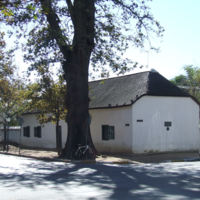
Stellenbosch Village Museum
Stellenbosch Village Museum is one of 28 museums affiliated with the Western Cape Provincial Government’s Museum Service. The Village Museum consists of four period houses dating from the early eighteenth century to the Victorian era. It opened during the 1970s as part of what was then a larger complex of museums in Stellenbosch. The museum was partially redeveloped by Museum Service staff in 2015, with new exhibition panels and an interactive historical timeline installed in the foyer area. Focus is given to the historical origins of Stellenbosch with attention given to a diverse range of historical actors, from the enslaved to Khoi people. This is an important part of moving historical interpretation at the Village Museum away from the whites-only affair established in the apartheid years. Artefacts uncovered during excavations of the period houses and their outbuildings are displayed, though these lack contextual information in places.
Slavery is not referred to in great detail in the exhibition panels, however it does feature on the interactive timeline. Both the abolition of the slave trade in 1807 and abolition of slavery in 1834 are referenced. Efforts are made to posit the Bletterman family – original owners of the Village Museum’s late eighteenth century property - as slave owners. Particular attention is given to the case study of the enslaved woman Manisa who was owned by Stellenbosch resident Johanna Barbara van Biljon. This focus comes from the unusual level of surviving material which enabled a reconstruction of Manisa’s life, including separation from her family through public auction. There is even a full body portrait of Manisa, taken from a Cape Argus article published upon emancipation. Problematically, one of the outbuildings of Bletterman House which potentially functioned as slave quarters has been rented out by the museum and presently houses a number of eateries. No connection is made between references to the outbuildings as slave quarters in the historical timeline and their present use.
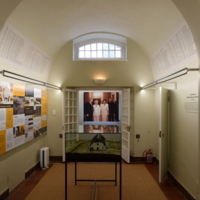
Vergelegen
Vergelegen is a wine estate, founded in 1700 and presently owned by Anglo-American subsidy AmFarms. As with the majority of South African wine farms of such a vintage, its early labour force rested on enslavement. Historical interpretation on the estate can be traced to an archaeological dig conducted by a team of academics from the University of Cape Town between 1990 and 1992. At a time of burgeoning scholarly enquiry into Cape slavery, this work excavated the former slave lodge on Vergelgen with the explicit intention of unearthing items which might hint towards the existence of slave culture. A number of personal items including coins and buttons were discovered, whilst the most significant find was of the skeletal remains of an enslaved woman who was affectionately named ‘Flora’ by estate staff.
The results of the archaeological work were displayed in the estate’s foyer together with contextual information. This made Vergelegen probably the first location in South Africa to mount a detailed exhibition relating to Cape slavery. The existence of the archaeological objects can be considered particularly significant, given that few tangible links with Cape slavery exist in museum collections. A second exhibition focussing on Vergelegen’s historical owners was developed several years later in the former manor house, and both exhibitions were subsequently amalgamated prior to being refreshed in 2016.
Presently, the names of people known to have been enslaved on Vergelegen are listed on the wall/ceiling of the first gallery, whilst the origins of enslaved people and their role on the estate are made clear. The objects unearthed during the early 1990s are displayed as tangible links with a past described by text. Additional historical context focuses on wine farming and the early Cape economy, historical estate owners, and notable visitors to Vergelegen.
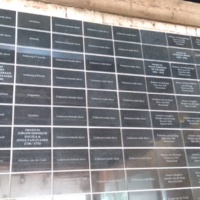
Solms Delta
Solms Delta is a wine estate, situated east of Cape Town in the heart of the Cape Winelands. It was founded as Zandvleit in 1690, with the name change coming in 2002 after purchase by University of Cape Town-based neurosurgeon Mark Solms who wished to distinguish it from other farms with the same name. As with the majority of South African wine farms of a similar age, its early labour force rested on enslavement. Solms approach to farm ownership has seen him attempt to eschew the well-worn white owner/black worker relationship by launching a socio-economic reform project. Money has been invested in new housing featuring satellite television, whilst an education project both for workers and their children has been established. Social enrichment activities based around music, sports, and performance have been encouraged in an attempt to improve the traditionally poor socio-economic circumstances of the workers, many of whom live on the estate just as their ancestors did. Solms has explained in interviews that this refreshed approach to wine farming arises from a perceived responsibility to acknowledge his own life privileges as a white South African. Crucially, workers have been given shares in a land equity scheme.
Solms Delta hosts two museums. One of these, named Museum van de Caab with deference to Cape slave naming patterns, opened at the same time as the estate opened to the public in 2005, with a music museum opening in 2014. Acknowledgement of the past as a means of understanding how workers have been exploited over time is a crucial part of Solms’ project. Slavery is referenced in both museums, with songs as evidence of slave culture appearing in the music museum. In Museum van de Caab it forms a fundamental part of a general farm history which traces the story of the land to the origins of humankind. A memorial feature occupies a prominent position in one of two galleries, detailing the names of every person revealed by archival research to have been enslaved on the estate. Guided museum and estate tours are available, conducted by estate workers.
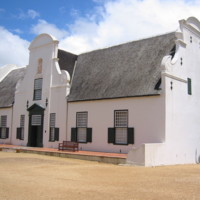
Groot Constantia
Founded in 1685, Groot Constantia is South Africa’s oldest wine estate. Like the majority of wine estates of a similar vintage in the Cape Town area, its labour force prior to emancipation in 1834 rested on enslavement. Following a vine disease outbreak in the late nineteenth century, the estate passed into government ownership. It is currently operated by the arms-length Groot Constantia Trust. The manor house was rebuilt in Cape Dutch style following a fire in 1925, and has operated as a preserved site since that time. The manor house passed into the control of the South African Cultural History Museum in 1969 and, as with other sites managed by the same entity, became part of southern state-funded umbrella Iziko Museums in 1998.
Iziko’s inauguration signalled a shift towards previously marginalised histories at all its sites, with Groot Constantia no different. A revised history of Groot Constantia paying greater attention to enslaved people was written by curator Thijs van der Merwe and published in 1997. Buildings which had potentially served either as stables and/or as slave quarters were repurposed as an Orientation Centre in October 2004. As the first heritage space which the visitor reaches upon arrival, displays in this building foreground the Cloete family – owners from 1779 to 1885 – as ‘farm owners and slave owners’. Drawn from archival research, their human transactions are listed, whilst the origins, names, and worked carried out by people enslaved at Groot Constantia are also listed. A panel is devoted to the ‘young servant boy’ Friday, whose ancestral origins are linked to the suppression of the slave trade by the British Royal Navy. The selection of this story can partially be attributed to the availability of suitable museological material, given that a photograph of Friday carrying Bonnie Cloete’s archery set is included.
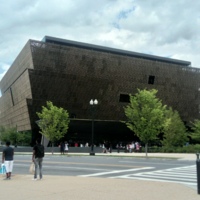
National Museum of African American History and Culture
The National Museum of African American History and Culture opened in September 2016, after more than a century of development. Designed to "tell the American story through the lens of African American history and culture," it forms the only national museum in the USA that is exclusively devoted to the documentation of African American history and culture. It stands on Washington's National Mall as the newest, nineteenth museum of the Smithsonian Institute. Established by an Act of Congress in 2003, the museum has had over one million visitors since its opening.
The displays in the museum are divided into two halves. There are three history galleries, charting key events in the history of America, with specific reference to the experience of the African American community. These galleries begin with displays about Africa prior to the slave trade, showcasing the rich culture and advanced nature of civilisations there. The displays then move on to enslavement, the Middle Passage and Plantation Life. In all of these displays, the experience of the enslaved people is central to the interpretation, and much use is made of archive material, providing quotations which bring the voices of the enslaved to the fore of the narrative.
The displays in the history galleries go on to interpret abolition, reconstruction, emancipation and Civil Rights. They end with the inauguration of Barack Obama in 2009. The displays make use of a wealth of collections, some 36,000 objects now belong to the museum. The key to the narrative throughout all of these displays is the central position of African Americans to the national history of America.
The other side of the museum consists of three 'community galleries.' Again these focus on the achievements of African Americans, through themes like sport, military, theatre, television, literature and art. Here, some of the museum's 'celebrity' artefacts, including Michael Jordan's NBA finals jersey and one of Jimi Hendrix's vests. This section of the museum also houses the 'Robert Frederick Smith Explore Your Family History Centre,’ where visitors can look at digitised archive material with expert guidance to explore their own family tree.
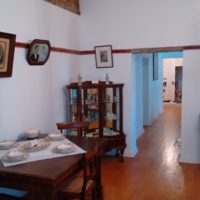
Pniel Museum
Pniel Museum is a small community-run museum which opened in 2013 in the village of Pniel, close to Stellenbosch. It has its roots in a long-running project, dating back to the unveiling of the Freedom Monument on the werf area of the former Papier Moelen manor house (which now houses the museum) in 1993. Pniel itself is a former Apostilic Union mission station which was established in 1843. Many of its early inhabitants were purportedly enslaved people looking for somewhere to settle following the ending of the five year apprenticeship period in 1839. It was designated a rural coloured group area under apartheid. A small group of locals have a clear sense of pride in their history, and embrace their connections with slavery which is taken as Pniel’s formative experience. The Freedom Monument – which celebrates emancipation – was reflective of this, and subsequent developments including two further monuments and the museum have advanced this engagement with the past. The museum itself offers a thorough overview of local history, partially laid out in the form of a historical farmhouse, and partially based on interpretive content. There is no exhibition dedicated to slavery at Pniel Museum, however the links between Pniel and slavery are evident at various points. Additionally, staff (local volunteers) are happy to talk about the links both they and Pniel hold with slavery. Perhaps the most important display in terms of slavery is a family tree of the Willemse family. At the top sits a photograph of Adriaan Willemse who is described as ‘a freed slave who settled on the Pniel mission station and became the father of almost 70% of Pniel inhabitants’. The museum functions as something of a community archive featuring donated objects ranging from cutlery to trade implements. There are, however, no objects which belonged to the village’s early and formerly enslaved inhabitants.
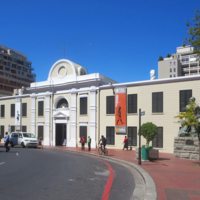
Slave Lodge
The Slave Lodge building was first constructed in 1679 by the VOC as housing for the people they enslaved. It was modified over time, and post-British settlement of the Cape was transformed into government offices. After passing through various stages of administrative use – most notably as the Supreme Court – it opened as the South African Cultural History Museum in 1967.
Typical of apartheid-era museology, its displays made no reference to the building’s connections with slavery. Post-apartheid, the museum was brought under the management of southern state umbrella Iziko Museums, and was renamed Slave Lodge in 1998. Although a number of its displays still date from the Cultural History Museum period, new exhibitions have been installed, and the museum now purports to serve as a centre where human rights abuses are discussed and exposed. There is a particular focus on slavery, and racial segregation under apartheid, both through permanent and temporary displays.
The main slavery exhibition is titled ‘Remembering Slavery’ and opened in 2006. This occupies the western wing of the ground floor of the museum. The exhibition offers a comprehensive overview of Cape slavery, with galleries focussing on contextual history, the Slave Lodge building, the middle passage, slave trading routes in the Indian and Atlantic Oceans, and a recreation of life in the eighteenth century Slave Lodge. Owing to the paucity of material remnants of slavery at the Cape, the exhibition relies on text to a large extent. Tapping in to the ‘reconciliation’ narrative of the early Mandela years, its overall effect is to portray slavery as a South African history which the country has learned from.
The opposite wing of the building hosts a changing selection of temporary exhibitions which have focussed on human rights abuses including the anti-apartheid struggle and women’s rights. The museum offers a comprehensive education programme with a particular focus on slavery.
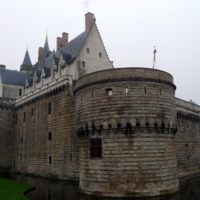
Musée d’histoire de Nantes
Musée d’histoire de Nantes (Nantes History Museum) was originally the residence of the Dukes of Brittany and the castle was restored in the 1990s. It opened to the public as a museum in February 2007. The museum is not wholly dedicated to looking at slavery, but explores the history of the castle and the city. However, it is acknowledged that the Atlantic slave trade is a key part of that history. The themes covered within the museum begin with the construction of the castle in the 13th century, and then follow the development of Nantes as part of Brittany through the ages until the 17th century. The museum also examines trade, the impact of the French Revolution, industrialisation, the two world wars and a contemporary look at Nantes as an ‘Atlantic City’. The museum added several rooms in 2016 that looked with greater detail at modern history. It has been designated a 'Monument Historique' by the French government. In addition to the historical artefacts housed in the museum, interactive and digital media is incorporated throughout as a part of the museum's aim to showcase the history of the city not only through objects and art work, but also contemporary technology.
Slavery is mainly addressed in the exhibition ‘Trade and Black Gold in the 18th Century’, where the displays address the role Nantes played as a key French port for vessels embarking on the Triangular Trade. Objects on display include maps, paintings and a collection of printed canvases produced in Nantes that would have formed a significant proportion of the cargo taken on the first leg of the trade voyage, from France to Africa. As well as examining France’s role in the logistical aspects of the trade, this exhibition also includes interpretation about Haiti. This interpretation has a dual focus, with Haiti as the destination for most of the ships originating in Nantes and the site of the most successful slave revolt in the western hemisphere.
Other exhibitions within the museum also look generally at the larger events in French history and how they changed Nantes’s relationship with slavery. Within the exhibitions on Nantes and the Revolution, the long process of abolition and then re-entrenchment of slavery under Napoleon are discussed in the interpretation. Until 1831 Nantes was still France’s largest slave trading port despite the activity being previously outlawed in 1816. Similar to the Memorial to the Abolition in Nantes, the Nantes History Museum intends to provide a reflection on local history both good and bad.
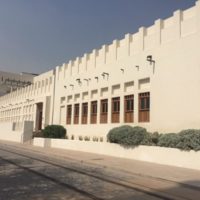
Bin Jelmood House
In the heart of downtown Doha, Bin Jelmood House forms one quarter of a new museum development, opened in 2015. The museum is located in a historic house in the Heritage Quarter of Msheireb Properties large development and forms an integral part of the city's regeneration project. It is the first museum to focus on slavery in the Arab world.
The aim of Bin Jelmood House is to raise awareness of human exploitation and to play a pivotal role in its abolition. It also provides a space for reflection on the continuing struggle and perseverance of different groups around the world, as well as acknowledging the long role that enslaved people have played in society, economically, socially and culturally.
The displays take the visitor back in time to discover how slavery has spread and developed over thousands of years. Visitors can engage with the stories of the origins, capture, transportation and daily tasks of the people who served in bondage, specifically those who did so across the Indian Ocean. The museum also examines the role that Islam has played in the treatment of enslaved people and their eventual emancipation.
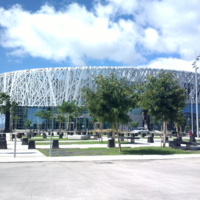
Memorial ACTe
On the former site of a sugar factory, Guadelopue's Memorial ACTe stands as a cultural institution that aims to preserve the memory of those who suffered during slavery, as well as to act as a space for discussion on the continuing repercussions. Part of UNESCO's Slave Route project, its main focus is on the challenges of bondage in the Guadeloupe islands. Memorial ACTe was opened in 2015 by then French President, Francois Hollande, and nineteen other heads of state.
The Memorial ACTe is a unique museum, both internally and externally, through its architectural design. It is also a centre for live arts and debates. It aims to provide interpretation through a variety of viewpoints and disciplines, using not only history but ethnology, social anthropology and history of art as well. The history of slavery and the slave trade are explored through a range of archival material, images and artefacts, with visual and audio installations too.
The permanent exhibition space examines the history of slavery from antiquity to the present day, using objects, reconstructions, visual and audio installations and digital interactives. The temporary exhibition space focusses on contemporary forms of artistic expression in relation to slavery around the world. In addition, there is a research centre where visitors can look into their genealogy, as well as a library and a conference hall.
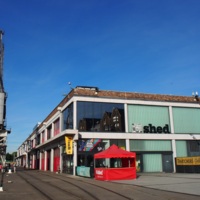
M Shed
M Shed opened in 2011 and is housed in a warehouse on Bristol’s dockside, a clear and tangible link to the history it interprets. The free-to-enter museum focuses on social history, exploring the development of Bristol as a city through people, places and daily life. It is a popular site, attaining over half a million visitors per year since 2013.
Through this local viewpoint, the museum explores Bristol’s involvement with the transatlantic slave trade and the abolition movement in its ‘Bristol People’ gallery which aims to ‘explore the activities past and present that make Bristol what it is.’ Voices from all factions of the slavery debate feature in the display, with proslavery, the enslaved, particularly those who fought for emancipation, and abolitionists all interpreted within dedicated cases. Each case contains a mix of objects, archive materials and text panels to tell the story. Quotations from key figures also bring to life the voices of those who were personally involved: for example, John Pinney, a plantation owner and sugar agent; Hannah More, a writer and Abolition campaigner; John Kimber, a slave ship captain accused (and acquitted) of murder; Silas Told, an ordinary sailor on slaving voyages. These Bristolian voices give different perspectives on how those involved in the trade saw it at the time. Quotations printed around the gallery also provide the views of today’s visitors to the trade. The exhibition also has sections about the legacies of the slave trade within Bristol, particularly in relation to the representation of African or Afro-Caribbean communities in popular culture, the presence of racism in the city, and the legacies of prominent slave owners in some of Bristol's public institutions.
The theme of antislavery also features as the starting point for a display on public protest movements. One case focusses on Thomas Clarkson’s visit to Bristol to collect information against the trade, another on the campaign to abstain from slave-produced sugar in the 18th century and the Bristol bus boycott against racist employment practices in the 20th century. This display then goes on to look at other popular campaigns and protest movements including women’s suffrage, riots, strikes and the Occupy movement. This perspective, situating the abolition campaign as the beginning of a British tradition of society campaigning, is a unique one across UK museums.
In the Bristol Life gallery, the stories of two Black Bristolians look at the new life for the runaway enslaved man, Henry Parker, and the Windrush generation Princess Campbell.
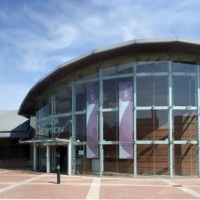
Wedgwood Museum
The Wedgwood company's founder, Josiah Wedgwood I, had the initial idea for preserving and curating a historical collection in 1774. A public museum dedicated to this purpose first opened in 1906, and moved to its present site in 2008. In 2009 the museum won the Art Fund Prize for Museums and Galleries. It underwent further redevelopment in 2015/16. The museum's rich collection of ceramics and archive material tell the story of Josiah Wedgwood, his family, and the business he founded over two centuries ago.
The collections at the museum make up one of the most significant single factory accumulations in the world. They contain a range of things from ceramics, archive material and factory equipment, to social history items that help interpret life in Georgian Britain. Key themes explored throughout the galleries include Wedgwood's links to royalty, the influence of nature on his work and his position as a successful entrepreneur.
On display in the museum also are a small collection of objects which relate to Wedgwood's prominent role in the campaign to abolish the British Slave Trade. Here, the display focusses on the production of the well-known antislavery medallion, which bears the 'Am I Not a Man and a Brother?' image. It also highlights Wedgwood's connection to Olaudah Equiano and the influence of proslavery factions in British society during the eighteenth and nineteenth century.
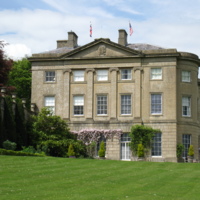
American Museum & Gardens
The American Museum in Britain is housed in a manor house, built in 1820 by English architect Sir Jeffry Wyatville. It is the only museum of Americana outside the USA and was founded to 'bring American history and cultures to the people of Britain and Europe'. It uses a rich collection of folk and decorative arts to interpret these traditions from America's early settlers to the twentieth century. Living history events bring these stories to life, in addition to changing temporary exhibitions which keep the narrative up to date. The museum opened to the public in 1961 as the brainchild of two antiques dealers.
The museum's collections are a rich source of furniture, portraiture and textiles from America, displayed thematically within period rooms acting as gallery spaces. The 'American Heritage' exhibition, charting the history of America through the narration of key events and people dominates a large proportion of this space. Key collections highlights in this exhibition include Martin Luther King's 'I Have a Dream' speech and a range of treasures from New Mexico.
Also contained within the 'American Heritage' exhibition is a small display about slavery and abolition in America. The main focal point of this display is a quilt made by enslaved people on a plantation in Texas. Other themes addressed here include the Underground Railroad, prominent abolitionists and the importance of the Civil War in the eventual abolition of slavery.
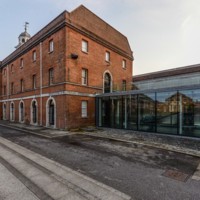
National Museum of the Royal Navy
The National Museum of the Royal Navy is located in Portsmouth’s Historic Dockyard. Its aim is, ‘to make accessible to all the story of the Royal Navy and its people from earliest times to the present.’ The museum, housed in a former naval storehouse, receives almost one million visitors per year.
Through five galleries, the museum charts the development of the Royal Navy and the experiences of the people who served in it. In the ‘Sailing Navy’ gallery, visitors can find out about the initial professionalisation of the navy during the eighteenth century. There are exhibits which discuss rations, health, hand-to-hand combat and available honours.
In this gallery, there is also a section of the display which discusses the other roles played by the Royal Navy, in addition to participation in conflict. The most striking exhibit in this section is a diorama model which depicts the use of the Royal Navy in the suppression of the slave trade, after the abolition of 1807. A little-known story in the British antislavery narrative, the model is accompanied by interpretive text which provides some context about the transatlantic slave trade and the campaign to abolish it. In addition, it also goes some way to outlining the prolonged involvement of Britain in eliminating other European slave trading in the years following 1807. While there are no artefacts used in narrating this story, the diorama itself provides a visualisation of the practice of suppression.
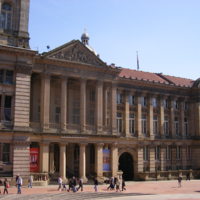
Birmingham Museum and Art Gallery
Birmingham Museum and Art Gallery has over forty display galleries that explore the development of Birmingham as a city, through its diverse communities. Since opening in 1885, the museum has built a vast collection of social history, art, archaeology and ethnographic items. It is one of nine sites managed by Birmingham Museums, the largest museums trust in the UK, whose vision for their service is, ‘to reflect Birmingham to the world, and the world to Birmingham.’ Housed within Birmingham's council buildings in the city's Chamberlain Square, the site welcomes around one million visitors a year.
Slavery and abolition feature as themed displays within the ‘Birmingham: Its People and Its History’ gallery, which dominates the third floor of the Victorian museum. Initially developed as part of the 2007 bicentennial commemoration activities, the displays highlight the contradictory nature of Birmingham’s relationship with the slave trade. Visitors are informed, through both interpretive text panels and collections artifacts on display, about the goods manufactured in Birmingham that were taken to Africa to trade in exchange for human beings. Simultaneously, the presence of antislavery activists in the city is explained, with digital interactives, portraits and abolitionist material culture all illustrating the role of Quakers and other prominent abolitionist figures, including Joseph Sturge and Olaudah Equiano.
The displays also alert visitors as to the existence of modern slavery by a panel headed with the words, ‘Around the world, people are still enslaved today.’ The visitors are then invited to leave their own comments as to how society can help to stop it in their community and around the world.
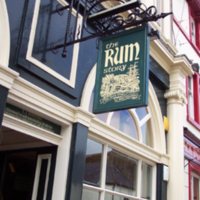
The Rum Story: The Dark Spirit of Whitehaven
‘Rum Story: The Dark Spirit of Whitehaven’ is a museum housed inside the former warehouse, office and shop of the Jefferson’s Rum Company in Cumbria. During the eighteenth and early nineteenth century Jefferson's would have been in receipt of slave-grown produce from the Caribbean, which would have been stored and processed in the museum's building.The museum opened in 2000 as part of the town’s regeneration project and aims ‘to bring history to life.’
On entering the museum, visitors walk through a series of room settings, from the African jungle at the beginning of enslavement, to a reconstruction of a slave ship hold complete with mannequins, and finally plantation offices . These room settings offer a very immersive experience, complete with opportunities for total sensory engagement; scent boxes, samples for tasting on exit and soundtracks all the way through.
The collections consist mainly of archival material which illustrates the company's connection to the Transatlantic Slave Trade, and how that made Whitehaven a prosperous port town. Interpretive panels explain the room settings, and diorama scenes with mannequins illustrate to visitors the way things were during the period, for both the enslaved and the workers in Jefferson's factory. The greatest asset that the museum has is the building itself, which provides a true, tangible link to the trade and its legacy on the local community.
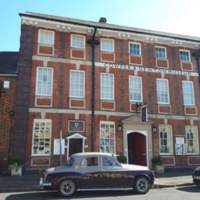
Cowper & Newton Museum
The Cowper & Newton Museum is a very small, local museum managed by a charitable trust and staffed predominantly by volunteers. The museum is situated in Orchard House, the home of poet and author William Cowper between 1768 to 1786. Since it opened in 1900, the museum has focussed on telling the story of Cowper’s life in the thriving Georgian market town of Olney, Buckinghamshire. The museum also examines Cowper's relationship with his friend and neighbour, slave-trader turned ordained priest and abolitionist, Reverend John Newton.
The museum’s mission is for visitors to ‘relive Georgian life in Olney.’ Using items of personal collections relating to both of the museum’s namesakes, the displays bring the house to life in the form of period room settings combined with display cases and interpretive panels. Both Cowper and Newton published writings against the slave trade and corresponded with other abolitionists, including William Wilberforce. The displays provide some context on the slave trade before outlining Cowper and Newton’s involvement in abolition. This is represented through a range of objects including archive material, portraits and furniture both from the museum’s collection, and loaned pieces from Wilberforce House Museum, Hull.
As well as being a theme which runs throughout the whole museum, with Cowper’s ‘The Negro’s Complaint’ on display in the Georgian History Room for instance, there is one particular room on the first floor of the house which focuses predominantly on the slave trade and abolition. Like most of the museums analysed here, the interpretive panels in this display were created using funds made available for the bicentenary in 2007.
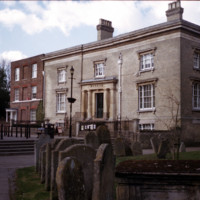
Wisbech and Fenland Museum
The Wisbech and Fenland Museum is one of the oldest, purpose-built museums in Britain. With its origins dating back to 1835, visitors are welcomed into a real ‘treasure house,' with collections housed in original nineteenth century cases. The museum is free to enter and focusses on local history, housing the vast and varied collection of the town’s literary and museum societies. Using these, the museum presents displays on a range of themes relating to key local industries, wildlife, archaeological finds and important people from the area.
One of these important people is Wisbech-born Thomas Clarkson, and it is through him that the theme of antislavery fills several of the largest cases in the main gallery. Using a combination of personal collections, archive material and objects linked to the wider slave trade (notably whips and a manacle), the museum follows Thomas Clarkson’s contribution to the abolition campaign, both in Britain and abroad. The museum also exhibits the narrative of Thomas’ brother John Clarkson who was instrumental in facilitating the movement of freed-slaves from Nova Scotia, Canada, to Sierra Leone.
This display was developed as a larger, standalone exhibition for the 2007 bicentenary entitled ‘A Giant with One Idea,’ but this was reduced following the end of the commemorations as funding was withdrawn.
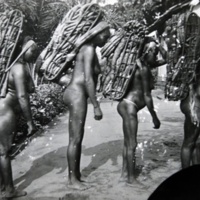
Carriers of Culture: Women, Food and Power from the Congo Basin, Museum of Archaeology and Anthropology, Cambridge University (October 2016 – March 2017)
Exploring the role of women and food from the Congo basin in the past and today, MAA’s first exhibition in our rebranded spotlight gallery is co-curated with the Congo Great Lakes Initiative.
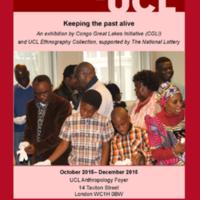
Keeping the Past Alive, UCL Anthropology Foyer (October 2015 - December 2015)
Keeping the Past Alive is a partnership between University College London's Ethnography Collection and Congo Great Lakes Initiative. The exhibition reflects the stories that Congolese community members share as and how they interact with objects, either personal, provocative or relational. It is divided into three topics: traditional power objects, sacred rituals and medicine, and everyday life. The objects on display tell stories, sometimes with a metaphor of their own, which will, we hope, make visitors internalize and discuss the messages they bring. This exhibition is the final step of our collaboration with Congo Great Lakes which started one year ago. During the project, an interactive platform which can host online exhibitions has been developed. The platform collects archives and documentation and shares the data with Horniman and UCL Congolese collections and members of CGLI.